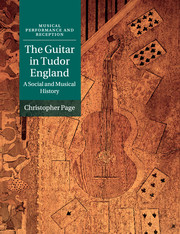Book contents
- Frontmatter
- Dedication
- Contents
- List of figures
- List of tables
- List of music examples
- Acknowledgments
- Note on music examples
- List of abbreviations
- Introduction
- 1 Imagery
- 2 Who owned a gittern?
- 3 The gittern trade
- 4 ‘An instruction to the Gitterne’
- 5 Sounding strings
- 6 The gittern and Tudor song
- 7 Thomas Whythorne: the autobiography of a Tudor guitarist
- Conclusion
- Appendix A The terms ‘gittern’ and ‘cittern’
- Appendix B References to gitterns from 1542 to 1605
- Appendix C The probate inventory of Dennys Bucke (1584)
- Appendix D Octave strings on the fourth and third course
- Appendix E The fiddle tunings of Jerome of Moravia, swept strings and the guitar
- Appendix F The mandore and the wire-strung gittern
- Appendix G The ethos of the guitar in sixteenth-century France
- Appendix H Raphe Bowle
- Bibliography
- Index
Conclusion
Published online by Cambridge University Press: 05 June 2016
- Frontmatter
- Dedication
- Contents
- List of figures
- List of tables
- List of music examples
- Acknowledgments
- Note on music examples
- List of abbreviations
- Introduction
- 1 Imagery
- 2 Who owned a gittern?
- 3 The gittern trade
- 4 ‘An instruction to the Gitterne’
- 5 Sounding strings
- 6 The gittern and Tudor song
- 7 Thomas Whythorne: the autobiography of a Tudor guitarist
- Conclusion
- Appendix A The terms ‘gittern’ and ‘cittern’
- Appendix B References to gitterns from 1542 to 1605
- Appendix C The probate inventory of Dennys Bucke (1584)
- Appendix D Octave strings on the fourth and third course
- Appendix E The fiddle tunings of Jerome of Moravia, swept strings and the guitar
- Appendix F The mandore and the wire-strung gittern
- Appendix G The ethos of the guitar in sixteenth-century France
- Appendix H Raphe Bowle
- Bibliography
- Index
Summary
There may be no better way to develop a deceptively peaceable view of English society in the sixteenth century than to trace the history of a Tudor musical instrument. As we review representations of the quarry in the visual arts, or sift archives and literary texts for germane references, any sense that Tudor England was a small country, threatened by encircling powers of a competing faith, is liable to fade. The battle to keep hunger at bay, which blighted the lives of somany, seems to be won as imported instruments come to the wharves of London in substantial quantities and enthusiasts fill their commonplace books with tablature. On one hand, this may not be so very misleading. Contemporaries repeatedly praised music for its power to give comfort and to revitalise the intelligence; only the trumpet in time of war, John Milton's ‘sonorous mettal blowingMartial sounds’, showed thatmusic could also be a summons to conflict (as opposed to conflict of opinion). On the other hand, however, to treat any musical instrument of the sixteenth centurymerely as a civilised pastime is to sunder it from its rawmaterials, the craftsmanship required to make it, the aspirations of its owners and the political circumstances, sometimes fraught, which affected its circulation.
Stringed instruments, fragile and relatively expensive creations, were luxuries in the sixteenth century that counted for most amongst those for whom they represented the most significant expense. This obviously does not mean the nobility or great families like the Kitsons of Hengrave Hall – though gitterns are found among them also – but rather the ‘middling sort’ whose instruments represented their aspirations, and therefore their struggles. Inventories made for probate show that many men and women of this broad category lived in houses that were inhabited larders with sacks of rye, barley and peas competing for space with bedding and furniture; the presence of a stringed instrument in such documents, especially if it be a gittern and therefore perhaps the cheapest variety available, ranks with the appearance of a gaming table, an array of pewter or a few books as the sign of someone who aspired to surround himself with possessions suggesting there might be more to life than the grind of business and the danger of a lean harvest.
- Type
- Chapter
- Information
- The Guitar in Tudor EnglandA Social and Musical History, pp. 166 - 173Publisher: Cambridge University PressPrint publication year: 2015

